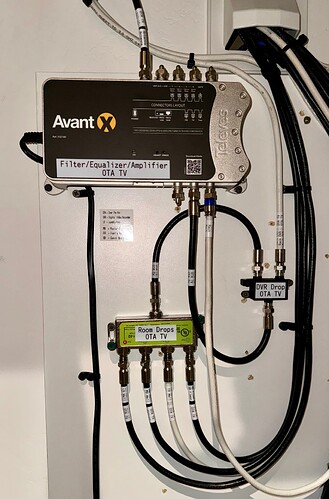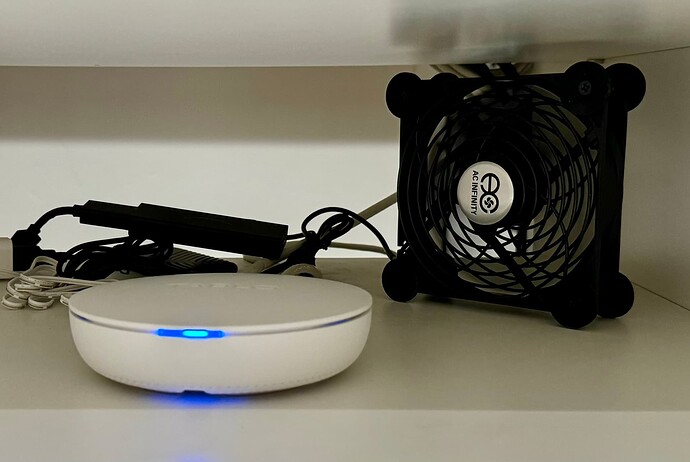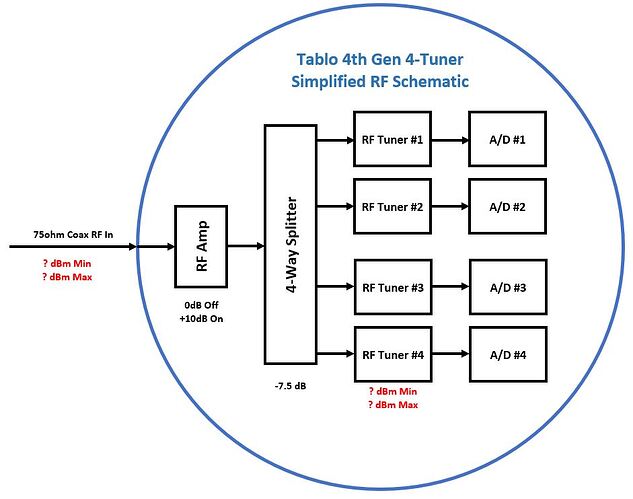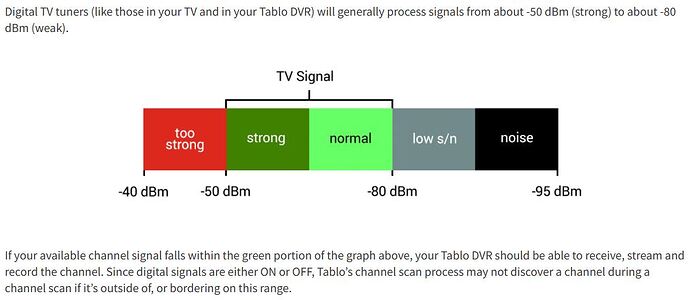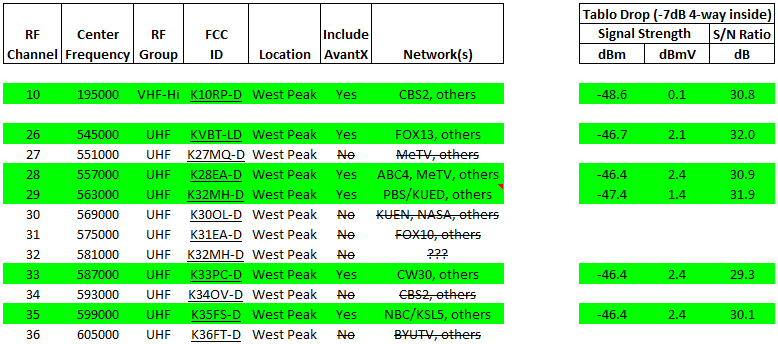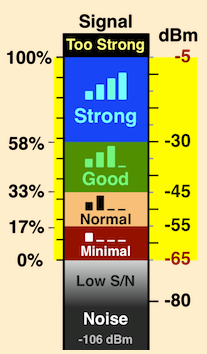I am a new Tablo user looking for an alternative to the Fire TV Recast that I have been using for a few years. Given the Recast has been discontinued, and I’m sick of the lack of software updates/support from Amazon (certainly won’t be any more now), I figure I need to do something.
I am a fairly experienced OTA TV “enthusiast”. Not that there has been any decent content lately, but I am still determined to make it work “well”, both for live viewing and recording. I have invested in very good OTA equipment/cabling/etc. feeding 4 TV’s (direct coax drops), the Recast (coax), and now the Tablo (coax). I use a Televes Ellipse Mix amplified antenna, and a Televes Avant X multiband filter/amplifier headend for my in-home coax distribution system. I know exactly what transmitters/virtual channels are available in my area and where they are (directionally). All of my selected transmitter RF signals are filtered/balanced/amplified prior to distribution in my home. Signal strength to each tuner is excellent/even, and s/n ratio is above 30dB on all but 1 transmitter, which is around 28dB. (As measured on my high-end Sony Bravia TV). I can very easily compare things like tuner performance on the various devices, and specifically compare the Recast and the Tablo side-by-side.
My home network includes 300Mbps fiber internet service/router, and a Cisco business class 26 port PoE switch. Almost everything in my home is hard wired Cat6 Ethernet (except cell phones, iPad, etc.). All 4 TVs of varying manufacturers have Amazon Fire TV Fire Stick 4K’s running on dedicated Ethernet cables back to the Cisco switch. All report about 90Mbps test speeds via the Fire TV Stick network utility (all Fire Sticks are 10/100 Mbps Ethernet connections), and have no trouble streaming HD movies without any stutter or delay. The Fire TV Stick on my main TV is the latest gen 4K Max version. The others vary, so I also can make some comparisons between Fire TV Stick versions.
I purchased a 4-tuner Tablo about 1 week ago, and now have it running (along with the Recast) on my home network. So far, I have been able to get it configured and working on all 4 TV’s (Fire Sticks) with very little fuss. In fact, despite all the horror stories I’ve read, it was very nearly “plug and play”. A pleasant surprise! Here are some of my observations so far, as well as comparisons to the Recast (in no particular order):
-
My wife and I both like the Tablo Fire TV app interface much more than the Recast. The only downside is it a separate app (just like other streaming apps such as MAX, Disney+, etc.), where the Recast interface integrates directly with Fire TV ecosystem. But, once in the Tablo app both the live grid and the recording operations are more modern and pleasant experiences than the Recast IMHO. Also, where the Recast has always had problems with its recording (e.g. reliable scheduling of series recordings), so far the Tablo seems much more reliable in this regard. The Tablo also does a much nicer job of presenting content options, “season premiers”, etc. more like some of the better streaming services. Overall, it’s a slicker interface than the Recast.
-
The Tablo runs pretty hot. My understanding is 55C is typical under load (4 tuners actively working??). I have checked a number of times with an infrared thermometer, and even “doing nothing” the Tablo base easily gets to 55C. The highest I’ve “clocked” is 57C. To be overly cautious, I set a spare USB computer fan next to it on the shelf, plugged that into a spare iPhone USB charger, and the Tablo temps are now much lower. I just checked it, and it was 35C.
-
The Tablo tuners (from an RF perspective), seem to be much better than the tuners in the Recast, as well as better than at least 2 of my TVs. I conclude this by comparing OTA stability/quality across all of my platforms, and noting that the Tablo seems to deliver (subjectively) better picture quality. My brother, who is also in the process of converting from Recast to Tablo in his home, makes the same observation. He is a bit of an audiophile, and also thinks the Tablo sound is somehow better than the Recast through his high-end home theater system. So, when the Tablo “behaves”, it seems to deliver a high quality picture and sound. But, it doesn’t always behave …
-
I see regular blue message screens from the Tablo app stating something like “Failure to decode audio …” or “Failure to decode video …”. The audio message often appears after launching the Tablo app. Hitting either “Retry” or “Cancel” seems to do exactly the same thing … clear the screen and move on to normal viewing behavior. The video message appears less often, and randomly during Live TV feeds (maybe once in 1-2 hours viewing). Again, hitting either “Retry” or “Cancel” seems to do exactly the same thing … clear the screen and move on to normal viewing behavior.
.
I suspect this is Tablo’s way if indicating it gagged decoding something from the OTA video feed … presumably due to a weak signal. However, I have very strong signals and high s/n ratios (above 30 dB), so this is puzzling to me. I think what is happening is the Tablo device and/or app struggles to handle occasional random errors in the digital stream. These can occur for any number of reasons … in my case I find almost all of them originate somewhere between the original broadcast towers in Salt Lake City, and the numerous “repeaters” on mountaintops before the transmitters in my area (Southern Utah) receive the relayed transmission. Of course, there can be (and have been) some local issues that have temporarily interfered with transmission/reception.
.
It’s worth noting that none of my 4 TV’s (of various ages/manufacturers) behave this way when watching OTA TV directly on their respective tuners from a direct antenna feed (via coax). They may “jump” or show misc. pixilation issues or drop audio for just a brief moment, but then they return to normal viewing behavior without my intervention. Also, the Recast sometimes briefly displays an annoying message overlay that says “weak or no signal… blah blah blah”, which disappears and normal viewing resumes (most of the time). Oddly, I see this message on the Recast even when the picture and sound seem perfectly fine. -
During live TV viewing, the Tablo audio/video sync seems very sensitive to little signal “blips” (digital trash), and easily gets out of whack. Sometimes this can be remedied by exiting back to the Guide and reselecting the same channel, sometimes it can be remedied by exiting the Tablo app back to Fire TV and reloading the Tablo app, and sometimes it requires a cold restart of the Tablo itself (unplug). None of my TV tuners exhibit this behavior, and only very rarely does the Recast do this. Once again, it seems the Tablo hardware/software struggles to handle errors in the data stream and quickly recover to continue normal viewing.
-
The Tablo system occasionally freezes Live TV video with the spinning blue circle for less than a minute, then continues on “normally”. Perhaps some sort of buffering but no real reason I can find based on the network performance.
-
Only once (so far) has the Tablo randomly crashed to a black screen during OTA TV viewing. In this case, I had to do a cold restart of the Fire TV Stick to get everything working. The Recast has never crashed any of my Fire TV Sticks in several years of use. The Tablo app randomly exits back to the Fire TV for no apparent reason. Maybe a dozen times in the first week of viewing a few hours a day. Re-entering the Tablo app is usually “normal” afterword. The Recast rarely just crashes back to Fire TV.
-
So far, the Tablo has reliably recorded about a dozen programs, and the few I have watched have been … dare I say … flawless. No issues with stuttering, spinning blue circles, or whatever. I have yet to see any of the issues noted regarding watching live TV recordings. Maybe I just haven’t yet watched enough Tablo recordings.
I think if I had one overall impression at this point, I would say the Tablo is close to an attractive replacement for the Recast, and it seems to have the potential to be considerably better. However, it’s just unreliable and unpredictable enough to still be a bit frustrating. I hope the Tablo folks continue improving the basic function (watch and record live TV) and reliability (handle the trash better) first and foremost, before trying to add too many more bells and whistles. It needs to be solid and stable!
I am sure I will learn more with more use. Perhaps others deciding whether to switch from Recast to Tablo will find this long post useful. Feel free to respond with other relevant experience and comments.
